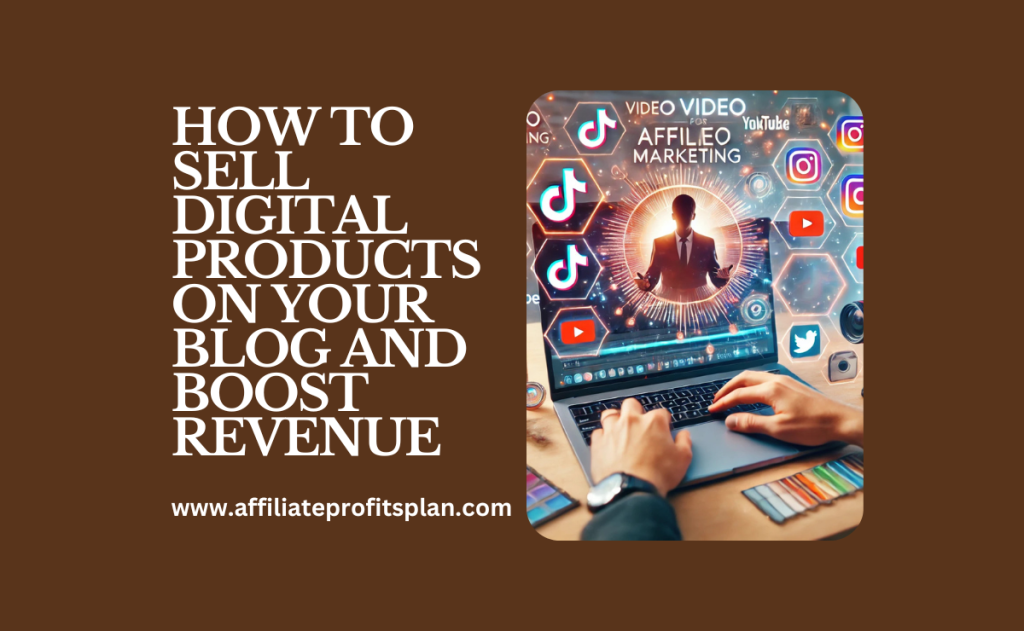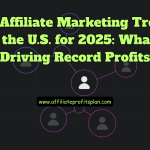Welcome to my article “How to Sell Digital Products on Your Blog and Boost Revenue” If you’ve ever dreamed of waking up to an inbox full of “You just made a sale!” notifications while still in your pajamas, selling digital products on your blog might just be your golden ticket. Unlike physical products, there’s no inventory, no shipping headaches, and no risk of accidentally sending someone a left shoe when they ordered a right. Digital products—whether it’s an eBook, an online course, or a set of fancy Canva templates—allow you to make money while you sleep (yes, really).
But before you start counting your future millions, there’s a strategy to this game. You need to choose the right product, set up your blog for seamless transactions, and drive targeted traffic to your sales pages. This isn’t about throwing a random PDF on your site and hoping for the best—it’s about creating a system that turns your blog into a money-making machine. In this guide, I’ll walk you through step-by-step how to pick the perfect digital product, sell it effectively, and scale your revenue like a pro. So grab your coffee (or something stronger), and let’s turn your blog into a profitable online business!
Access Our Proven Tested Formula for $50-$100 Daily Income – Watch This FREE Video >>

Choosing the Right Digital Product to Sell
So, you’ve decided to sell digital products on your blog—great choice! Now comes the big question: What exactly should you sell? You don’t want to create something that collects virtual dust while your audience scrolls past it like an old meme. You need a high-value, irresistible digital product that your readers actually want to buy.
Step 1: Play to Your Strengths
The best digital products come from your expertise, passion, or experience. Are you a Canva wizard? Sell customizable templates. A fitness guru? Create an online workout plan. A blogging ninja? Package your knowledge into an eBook or course. The key is to leverage what you already know so you’re not spending months researching a topic you barely understand (unless you enjoy stress and existential crises).
Step 2: Solve a Problem
People buy digital products for one reason: to make their lives easier. Whether it’s learning a new skill, getting organized, or growing their business, your product should offer a clear solution. A good hack? Check your blog comments, emails, or social media DMs—what questions are people asking you repeatedly? That’s your goldmine!
Step 3: Validate Your Idea
Before pouring your soul into creating a digital product, make sure there’s actual demand. Here’s how:
- Run a poll on your blog or social media to see what your audience wants.
- Check platforms like Etsy, Udemy, or Gumroad—if similar products are selling, that’s a green light.
- Offer a freebie first (like a mini eBook or template) and see how many people grab it. If downloads are slow, your idea might need a tweak.
Step 4: Keep It Simple (At First!)
Your first digital product doesn’t have to be a 20-hour video course with Hollywood-level production. Start with something simple yet valuable—like a PDF guide, a checklist bundle, or a small paid webinar. You can always expand later once you’ve nailed your audience’s needs and buying behavior.
Step 5: Price It Right
Pricing can make or break your sales. Too cheap? People might think it’s low-quality. Too expensive? They’ll run for the hills. A good rule of thumb:
- Ebooks & Templates → $10 – $50
- Online Courses → $50 – $500+
- Coaching & Memberships → Subscription-based pricing
Consider offering a “no-brainer” deal—like an introductory discount or a bundle offer to entice first-time buyers.
Final Thoughts
Picking the right digital product isn’t about what you think is cool—it’s about what your audience actually wants and is willing to pay for. Take the time to validate your idea, keep it simple, and make sure it solves a real problem. Once you get that right, you’re well on your way to turning your blog into a digital cash machine.
Setting Up Your Blog for Selling Digital Products
Alright, you’ve picked the perfect digital product—now what? You can’t just slap a “Buy Now” button on your homepage and hope for the best. Your blog needs to be optimized for selling, which means setting up a seamless system that makes purchasing as easy as ordering pizza online (but without the regret of eating an entire large by yourself).
Step 1: Choose the Right E-Commerce Platform
Your blog may be your digital home, but it needs a reliable “checkout counter” where visitors can purchase your products hassle-free. Here are some popular options to help you set up shop:
- Gumroad – Perfect for selling eBooks, templates, and memberships.
- SendOwl – A great option for automating digital product delivery.
- WooCommerce (for WordPress) – If you’re using WordPress, this plugin turns your blog into a full-fledged e-commerce store.
- Shopify (with digital product apps) – Ideal if you want a more robust online store with built-in payment processing.
Pick a platform that fits your needs—simple setup, secure payments, and automatic delivery of digital products (because manually emailing PDFs at 2 AM is not a sustainable business model).
Step 2: Create a High-Converting Sales Page
Your sales page is your digital storefront, and it needs to do one job: convince people to buy! Here’s what you need:
✅ A catchy headline – Instantly tell visitors what your product does (e.g., “Master Pinterest Marketing in 7 Days—Without Paying for Ads!”).
✅ Compelling product description – Highlight the problem it solves and how it benefits your audience.
✅ Eye-catching visuals – Use product mockups, screenshots, or even short demo videos.
✅ Social proof – Testimonials, case studies, or reviews to show that your product actually works.
✅ A strong call to action (CTA) – Something clear like “Get Instant Access” or “Download Now.”
Your goal? Make it impossible for visitors to leave without buying!
Step 3: Set Up a Smooth Checkout Process
Nobody likes a complicated checkout process. The more steps, the more likely customers will abandon their cart and go binge-watch Netflix instead.
- Use trusted payment processors like PayPal, Stripe, or Apple Pay for a secure and fast experience.
- Offer multiple payment options (credit cards, PayPal, Google Pay) to accommodate different buyers.
- Automate product delivery so customers receive their downloads instantly—because waiting for an email confirmation feels like waiting for water to boil.
Step 4: Optimize for SEO & Mobile Users
Most people discover products through search engines, so don’t forget to optimize your blog and product pages for SEO:
- Use keywords related to your digital product in titles, descriptions, and URLs.
- Add internal links from your blog posts to your product sales page.
- Ensure fast loading speeds (Google hates slow sites, and so do your customers).
- Make your site mobile-friendly—because a huge chunk of your audience is browsing from their phones while pretending to work.
Step 5: Build an Email List for Future Sales
Not everyone who visits your blog will buy on the first visit. That’s why you need an email list—so you can nurture leads and turn them into paying customers later.
- Offer a freebie (like a checklist or mini eBook) in exchange for email sign-ups.
- Send valuable content + occasional product promotions.
- Use email automation to follow up with potential buyers and remind them why they need your product.
Final Thoughts
Selling digital products on your blog isn’t just about having a great product—it’s about creating a smooth and irresistible buying experience. Set up your sales pages strategically, keep your checkout process simple, optimize for SEO, and grow your email list. Do it right, and your blog will start generating revenue while you sleep. (Or at least while you binge-watch your favorite series guilt-free.)
Driving Traffic to Your Blog and Product Pages
So, you’ve got your digital product set up, your checkout process is smoother than a fresh jar of peanut butter, and your sales page is looking like a million bucks. Now, there’s just one small problem… where are the buyers?
Without traffic, your blog is like a fancy store in the middle of a deserted island—beautiful, but completely useless. So, let’s talk about how to bring in visitors who are ready to buy.
Access Our Proven Tested Formula for $50-$100 Daily Income – Watch This FREE Video >>
1. Leverage SEO: Get Found on Google (for Free!)
Think about how you find new products online—Google is your best friend. Your goal is to make sure your blog and product pages appear when people search for solutions in your niche.
Here’s how to SEO your way to success:
✅ Use the right keywords – Find what people are searching for using tools like Google Keyword Planner, Ubersuggest, or Ahrefs. Example: If you’re selling “Instagram growth templates,” target phrases like “how to grow on Instagram fast.”
✅ Write SEO-optimized blog posts – Don’t just push products—create valuable content! If you’re selling an eBook on email marketing, write a post like “5 Email Subject Lines That Get 80% Open Rates” and link to your product inside.
✅ Optimize your product page – Use clear headlines, descriptions, and alt text for images to improve search rankings.
✅ Internal linking – Link from your blog posts to your product pages to boost their visibility and encourage readers to check them out.
SEO is a long-term game, but once it works, you’ll get a steady stream of organic traffic—without spending a dime on ads.
2. Drive Traffic Through Social Media (Without Feeling Like a Salesperson)
Social media is a goldmine for getting eyeballs on your blog and products—if you use it the right way. No one wants to follow a walking sales pitch. The key? Provide value first, sell second.
Here’s how to turn social platforms into traffic machines:
🚀 Pinterest – It’s not just for recipes and DIY projects. Create eye-catching pins for your blog posts and product pages, optimize them with keywords, and watch them go viral.
🚀 Instagram & TikTok – Short-form videos are king! Show how your digital product works, share success stories, and use CTA captions like “Grab your copy now – link in bio!”
🚀 Twitter/X & LinkedIn – Great for sharing valuable insights and linking to your blog posts naturally. Engage in conversations related to your niche to attract potential buyers.
🚀 Facebook Groups & Reddit – Don’t just drop links (nobody likes that). Instead, be helpful in niche communities, then subtly mention your blog when it adds value to the discussion.
Pro Tip: If one platform is bringing in the most traffic, double down on it instead of spreading yourself too thin!
3. Build an Email List (Because Social Media Can’t Be Trusted)
Social media is great, but here’s the harsh truth: you don’t own your followers. Platforms can change algorithms overnight (looking at you, Facebook 👀), and suddenly, your reach is gone. That’s why email marketing is a must.
Here’s how to turn blog visitors into subscribers—and buyers:
📩 Offer a free lead magnet (e.g., a checklist, mini eBook, template) in exchange for their email.
📩 Use an exit-intent pop-up so visitors don’t leave empty-handed.
📩 Send valuable content + product recommendations (not just “BUY NOW” emails).
📩 Set up an automated email sequence to warm up new subscribers and pitch your product naturally.
Think of email marketing as your VIP club—you own your list, and you can sell to them anytime!
4. Collaborate with Influencers & Affiliates (Leverage Other People’s Audiences)
If you’re just starting out, why not borrow traffic from someone who already has an audience?
🔹 Partner with influencers – Find micro-influencers in your niche (even with 5K–10K engaged followers) and offer them a free copy of your product in exchange for a review or shoutout.
🔹 Start an affiliate program – Let others sell your digital product for a commission. This way, you get more sales without spending upfront on ads. Platforms like Gumroad and SendOwl have built-in affiliate features.
🔹 Guest post on popular blogs – Write a guest post for a well-known site in your niche and link back to your blog. Instant credibility + new traffic!
These strategies help you tap into an audience that’s already engaged—and that means faster results.
5. Run Paid Ads (Without Burning Money)
If you’re ready to scale traffic fast, paid ads can be a game-changer. But don’t just throw money at Facebook and hope for the best—ads need a strategy.
🔥 Best platforms for digital product ads:
- Facebook & Instagram Ads – Target people interested in your niche with engaging visuals and a strong CTA.
- Pinterest Ads – Since Pinterest users are always looking for solutions, they’re more likely to buy.
- Google Ads – Great if you rank for high-intent searches (e.g., “Best templates for social media marketing”).
- YouTube Ads – If you have video content, running targeted ads can bring in high-converting traffic.
Pro Tip: Always test different ad creatives and audiences to see what works best—don’t just set it and forget it!
Final Thoughts: Build It, Drive It, Sell It!
Your blog won’t magically attract buyers overnight, but with the right SEO, social media strategy, email marketing, collaborations, and even paid ads, you can create a steady stream of traffic that converts into revenue.
Start with free methods like SEO and social media, then scale up with email marketing and paid promotions once you know what works. And most importantly, stay consistent—because success isn’t about a one-time traffic spike, it’s about building a system that brings in buyers on autopilot.
Now, go get those visitors—and those sales!
Boosting Revenue with Advanced Monetization Strategies
So, you’ve set up your blog, picked the perfect digital product, and you’re driving traffic like a pro. Sales are rolling in, but now you’re thinking, “How do I take this to the next level?”
Good news: there’s a whole world beyond basic sales, and it’s packed with advanced monetization strategies that can significantly boost your revenue. Let’s dive in!
1. Upsells & Cross-Sells: The ‘Would You Like Fries with That?’ Approach
Ever noticed how fast-food chains make more money after you’ve already placed an order? That’s exactly what upsells and cross-sells do for your digital products.
Here’s how to increase the value of every sale:
🔹 Upsell a premium version – If someone buys your eBook for $19, offer them an expanded version with bonus content for $49.
🔹 Cross-sell complementary products – If a customer grabs your Instagram growth templates, offer them a “30-Day Social Media Content Calendar” at checkout.
🔹 Order bumps – Add a one-click option for a small add-on (e.g., “Get this exclusive checklist for just $5 extra!”).
Most people are already in buying mode—so giving them more options boosts your revenue without increasing traffic.
2. Subscription Models & Memberships: Get Paid on Repeat
Want to turn one-time buyers into loyal, paying members? Offer a subscription!
Here’s why memberships are a game-changer:
💰 Predictable income – Instead of relying on sporadic sales, you get steady monthly revenue.
💰 More value for customers – Give ongoing access to exclusive content, templates, or coaching.
💰 Higher lifetime value – Even if a customer stays for just 3–6 months, you’ve earned way more than a single purchase.
Examples:
- A monthly membership for premium design assets
- A coaching community with live Q&As
- An exclusive newsletter with high-value insights
Platforms like Patreon, Podia, and MemberPress make it easy to start a membership program.
3. Affiliate Marketing: Earn Money from Other People’s Products
If your audience trusts you, why not recommend useful tools and products that align with your niche? With affiliate marketing, you earn a commission on every sale—without creating new products yourself.
How to maximize affiliate earnings:
✅ Choose high-paying affiliate programs – Look for commissions above 30% or recurring payments (e.g., SaaS tools).
✅ Promote products you actually use – Your audience can smell inauthenticity from a mile away.
✅ Create in-depth reviews & tutorials – Show how the product works and why it’s valuable.
✅ Include affiliate links in blog posts & emails – Passive income at its finest!
Examples of high-converting affiliate products:
- Web hosting (Bluehost, SiteGround)
- Online courses (Udemy, Teachable)
- Business tools (ConvertKit, Canva, Jasper AI)
With the right strategy, affiliate marketing can add thousands to your monthly revenue—without extra effort.
4. Bundles & Limited-Time Offers: The Scarcity Effect
People love a good deal, especially when it feels exclusive. That’s why bundling your products or offering limited-time discounts can skyrocket your sales.
Proven tactics to increase urgency:
🔹 Bundle multiple products at a discount – Example: Instead of selling 3 digital planners separately, offer them as a “Productivity Bundle” for a limited-time price.
🔹 Create seasonal or holiday deals – Black Friday, New Year’s resolutions, and back-to-school sales = easy money.
🔹 Use countdown timers – Nothing triggers action like “Only 12 hours left to get this deal!”
Scarcity and urgency = higher conversions, more sales, and boosted revenue.
5. Sell Licensing & White-Label Rights: Get Paid While Others Sell for You
If your digital product is really valuable, why not let other people sell it for you—while you still make money?
🔹 Licensing – Allow businesses to resell your product under their brand for a fee.
🔹 White-labeling – Offer a customizable version that others can rebrand as their own.
🔹 Agency or commercial licenses – Let agencies use your templates, courses, or tools for their clients.
Example: If you sell social media templates, agencies might pay a premium for the rights to use them with multiple clients. More revenue, less work for you.
Final Thoughts: Maximize Every Sale, Every Visitor, Every Dollar
Selling digital products isn’t just about creating a great product—it’s about strategically increasing revenue per customer.
What to do next:
✅ Add upsells, cross-sells, and bundles to boost sales instantly.
✅ Create subscriptions or memberships for recurring income.
✅ Use affiliate marketing to monetize content beyond your own products.
✅ Tap into scarcity and urgency with time-limited offers.
✅ Explore **licensing and
Conclusion: Turning Your Blog into a Money-Making Machine
Congratulations! You’ve just unlocked the blueprint for selling digital products on your blog and turning it into a revenue-generating powerhouse. From choosing the right product to setting up a seamless sales process, driving traffic, and using advanced monetization strategies—you’re now armed with everything you need to succeed.
But let’s be real: success doesn’t happen overnight. You won’t wake up tomorrow to find your PayPal account overflowing with sales (though wouldn’t that be nice?). The key is consistency, strategy, and a willingness to experiment. Some products will sell like hotcakes, others…not so much. That’s okay! Learn from the data, tweak your approach, and keep optimizing.
Access Our Proven Tested Formula for $50-$100 Daily Income – Watch This FREE Video >>
Final Pro Tips to Remember:
✅ Know your audience – The better you understand their needs, the more likely they are to buy.
✅ Focus on quality – Whether it’s an eBook, template, or course, make sure it delivers real value.
✅ Promote, promote, promote – Even the best products won’t sell if no one knows they exist.
✅ Test different strategies – Upsells, memberships, affiliate marketing—mix and match to see what works best.
✅ Stay patient – Most successful bloggers didn’t make six figures overnight. But they stuck with it.
At the end of the day, selling digital products on your blog is one of the best ways to create passive income and financial freedom. Put in the effort now, and your blog can become a 24/7 money-making machine that works while you sleep.Now, it’s time to take action. What digital product will you launch first?
Thanks a lot for reading my article on “How to Sell Digital Products on Your Blog and Boost Revenue” till the end. Hope you’ve helped. See you with another article.










